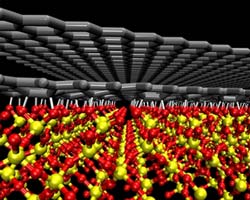Light-Speed Nanotech: Controlling the Nature of Graphene

Researchers at Rensselaer have developed a new method for controlling the conductive nature of graphene. Pictured is a rendering of two sheets of graphene, each with the thickness of just a single carbon atom, resting on top of a silicon dioxide substrate. <br>
Graphene, a one-atom-thick sheet of carbon, was discovered in 2004 and is considered a potential heir to copper and silicon as the fundamental building blocks of nanoelectronics.
With help from an underlying substrate, researchers for the first time have demonstrated the ability to control the nature of graphene. Saroj Nayak, an associate professor in Rensselaer’s Department of Physics, Applied Physics, and Astronomy, along with Philip Shemella, a postdoctoral research associate in the same department, have determined that the chemistry of the surface on which graphene is deposited plays a key role in shaping the material’s conductive properties. The results are based on large-scale quantum mechanical simulations.
Results show that when deposited on a surface treated with oxygen, graphene exhibits semiconductor properties. When deposited on a material treated with hydrogen, however, graphene exhibits metallic properties.
“Depending on the chemistry of the surface, we can control the nature of the graphene to be metallic or semiconductor,” Nayak said. “Essentially, we are ‘tuning’ the electrical properties of material to suit our needs.”
Conventionally, whenever a batch of graphene nanostructures is produced, some of the graphene is metallic, while the rest is semiconductor. It would be nearly impossible to separate the two on a large scale, Nayak said, yet realizing new graphene devices would require that they be comprised solely of metallic or semiconductor graphene. The new method for “tuning” the nature of graphene is a key step to making this possible, he said.
Graphene’s excellent conductive properties make it attractive to researchers. Even at room temperature, electrons pass through the material effortlessly, near the speed of light and with little resistance. This means a graphene interconnect would likely stay much cooler than a copper interconnect of the same size. Cooler is better, as heat produced by interconnects can have negative effects on both a computer chip’s speed and performance.
Results of the study were published this week in the paper “Electronic structure and band-gap modulation of graphene via substrate surface chemistry” in Applied Physics Letters, and are featured on the cover of the journal’s January 19 issue.
Large-scale quantum simulations for the study were run on Rensselaer’s supercomputing system, the Computational Center for Nanotechnology Innovations (CCNI).
Researchers received funding for the project from the New York State Interconnect Focus Center at Rensselaer.
Media Contact
More Information:
http://www.rpi.eduAll latest news from the category: Physics and Astronomy
This area deals with the fundamental laws and building blocks of nature and how they interact, the properties and the behavior of matter, and research into space and time and their structures.
innovations-report provides in-depth reports and articles on subjects such as astrophysics, laser technologies, nuclear, quantum, particle and solid-state physics, nanotechnologies, planetary research and findings (Mars, Venus) and developments related to the Hubble Telescope.
Newest articles

Superradiant atoms could push the boundaries of how precisely time can be measured
Superradiant atoms can help us measure time more precisely than ever. In a new study, researchers from the University of Copenhagen present a new method for measuring the time interval,…

Ion thermoelectric conversion devices for near room temperature
The electrode sheet of the thermoelectric device consists of ionic hydrogel, which is sandwiched between the electrodes to form, and the Prussian blue on the electrode undergoes a redox reaction…

Zap Energy achieves 37-million-degree temperatures in a compact device
New publication reports record electron temperatures for a small-scale, sheared-flow-stabilized Z-pinch fusion device. In the nine decades since humans first produced fusion reactions, only a few fusion technologies have demonstrated…





















